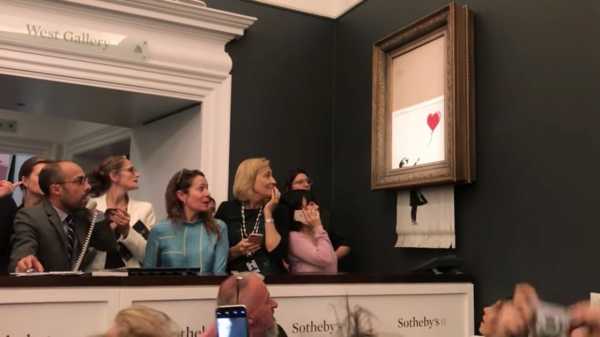
Until last week, the world’s most famous self-destructing work of art was Jean Tinguely’s “Homage to New York.” The Swiss artist’s sculpture—a motorized contraption that was twenty-seven-feet tall and incorporated a bathtub, a player piano, drums, a go-kart, a weather balloon, and much more—went up in smoke, in the garden at MOMA, in 1960, as a couple of hundred people looked on. Before the piece was able to fully demolish itself, the fire department stepped in. As D. A. Pennebaker, who filmed the event, later described it, “Out of the audience stepped a man in uniform who presented Jean with a document he took to be an expression of artistic enthusiasm, but which turned out to be a citation for disturbing the peace and violating the city fire code. I’m not sure if anyone ever paid it.”
Whether anyone will pay for Banksy’s painting of a girl and a balloon, which began shredding itself moments after it sold at auction for $1.4 million, in London, on Friday night, remains to be seen. Sotheby’s hasn’t disclosed the buyer’s identity. (Such opacity is business as usual in the art market.) If they were shelling out for love of the image alone, I would suggest picking up a replacement at Target, where a print version is currently on sale for $36.79, down from forty-six dollars. But, if they’re buying for investment, they might as well follow through. The picture’s destruction, like that of Tinguely’s machine, was halted before the job was complete, and there is already speculation that the work in damaged form will become even more valuable than it was before. If the stunt was intended to mock the spectacle of art being reduced to a price tag, this might mean the joke is on Banksy. But since it was clearly also a bid for more notoriety—for an artist bent on maintaining anonymity, Banksy does not shy away from the limelight—a cynic might call this is his best art work yet. Since Sunday, the spectacle has been viewed nearly nine million times, in a video that Banksy posted to Instagram. The clip, which also purports to show Banksy concealing a shredder inside the painting’s thick frame “a few years ago,” is captioned with a quote misattributed to Picasso (the Russian anarchist Mikhail Bakunin is the man who said it): “The urge to destroy is also a creative urge.” So much for the outlaw who used to reject the label “artist” in favor of “quality vandal.” Now Banksy joins the ranks of Jay-Z, name-checking the Spanish painter in a bid for masterpiece cred.
Was someone at Sotheby’s in on the prank? The company denies it, but conspiracy theorists point to the convenient timing of the lot hitting the auction block at the very end of the sale. Grand finales aren’t part of auction theatrics, but sound bites are, and “It appears we just got Banksy-ed”—as Alex Branczik, the auction house’s head of contemporary art in Europe, told reporters at the post-sale news conference—has already launched countless headlines. The last work of Banksy’s to perform this well at auction was a collaboration with Damien Hirst, who, too, is no stranger to gaming the system. In 2008, Hirst staged an unprecedented sale of his own work, also at Sotheby’s, consigning more than two hundred pieces directly from his studio, rather than in the pre-owned condition that is the custom at auction. The two-day event raked in a hundred and eleven million pounds, or about two hundred million dollars, just as Lehman Brothers was collapsing, making Hirst a symbol of art-as-excess. Here’s a theory: Hirst was the seller of “Girl with Balloon” and in on the prank. Of course, the identity of the consigner is as shrouded in mystery as the buyer’s is. What is a matter of public record is that the seller acquired the picture directly from the artist, in 2006, the same year that Banksy agreed to participate in a show that Hirst curated of his art collection, at London’s Serpentine Gallery. Early last week, Hirst announced, through a spokeswoman, that he is scaling back his operation “to cut the corporate elements of the business.” Here’s hoping he has better luck than Banksy, whose stunt cutting fails to rise above the level of empty gesture.
Sourse: newyorker.com






